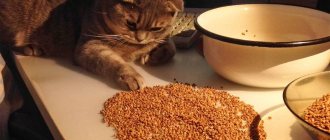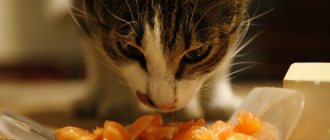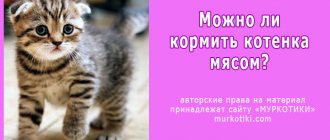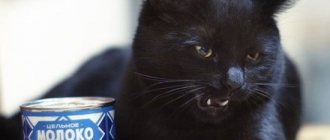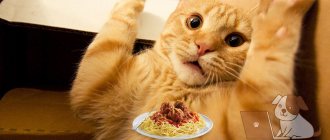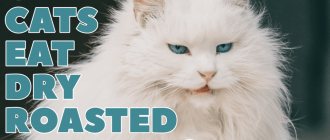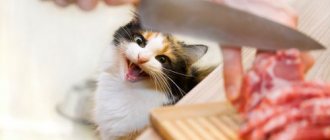Fruits and vegetables are beneficial not only for the human body; veterinary doctors also recommend giving them to cats. Plant products contain important elements for the normal growth and development of animals. However, not every vegetable and fruit is beneficial for the pet’s body, so the owner should first figure out what exactly is acceptable to include in the pet’s diet.
What vegetables can you give your cat?
In plant foods, fiber is the main value for cats.
It is not digested and does not contain nutrients, but it helps remove swallowed fur from the stomach, improves intestinal motility, and stabilizes stool. Vegetables bring moisture into the body; cats are reluctant to drink pure water and prefer to receive it with food. Cats absorb micronutrients of plant origin. In healthy animals, vegetables make up 5–10% of the diet. For overweight cats, the amount is increased to 20%. Plant fiber gives you a feeling of fullness, but does not increase calorie content. For cats, choose only fresh food without rot, damage, or stains. Frozen ones are also good; they retain the beneficial ingredients.
Vegetables are properly processed:
- First, wash under cold water, peel, and remove the seeds.
- When cooking, do not add salt, spices or seasonings. They disrupt water balance and metabolism. It’s healthier to cook fresh ones in meat broth instead of water, while frozen ones are steamed.
- Vegetables are chopped: raw ones are grated, greens are chopped with a knife, boiled ones are finely chopped or passed through a strainer or blender.
- Cooked vegetables are given as an independent “dish”, diluted with broth or mixed with meat, the proportions are adhered to: 3/4 protein food, 1/4 vegetable food.
- Add 3-5 drops of olive or sunflower oil to the prepared food; without it, fat-soluble vitamins will not be absorbed.
It is difficult to imagine a cat who eats only vegetables, but if this happens, he gets sick and dies. Plants do not contain animal proteins, amino acids, or fatty acids that cats need. Cats do not like vegetables with a strong, bitter taste. It is better to choose neutral types that absorb and do not clog the smell of meat.
The table indicates the crops that can be added to the diet:
| Kinds | Benefits for the cat |
| Carrot | Includes beta-carotene, it synthesizes vitamin A and is not destroyed by heat treatment |
| Zucchini | Contains antioxidants, iron. Soft fiber does not irritate the intestines |
| Pumpkin | Includes the rare component carnitine, it accelerates fat burning, helps build muscle mass, and renews the gastrointestinal mucosa |
| Beet | Dietary fiber supports the excretory functions of the intestines. The vitamin and mineral composition does not change after cooking |
| Broccoli | Increased amount of vitamins B, C, K, carotene |
| Cucumber | Improves the absorption of meat proteins |
| Green bean | It has a rich composition of minerals, 100 g contains only 30 kcal |
| Cauliflower | Includes few hard fibers, so it is easily digested and does not irritate the stomach. |
| Leaf salad | The amount of calcium is not inferior to dairy products, has a beneficial effect on the liver |
| Parsley, celery, dill | Enrich food with microelements, accelerate urine excretion, warns the ICD |
| Spinach | Useful composition of vitamins and minerals, preserved after heat treatment |
If the animal refuses vegetables, you will have to add bran to the “dishes” or grow grass from sprouted grains of barley, oats, and wheat.
The benefits of fruits and vegetables for cats
High-quality industrial complementary foods of the premium and super-premium segment necessarily contain vegetable additives. This is not surprising, since plant foods include a lot of useful substances, including carbohydrates, proteins, fats, phosphorus, fiber. Despite the fact that the cat’s body is not able to digest the latter and it is excreted in its original form, its benefits cannot be overestimated.
With the help of fiber, it is possible to push the food bolus through the intestines, achieve the adsorption of harmful substances and form feces.
Fruits also contain a large number of elements required for the normal functioning of a cat. They maintain body tone and help in the prevention of various pathologies. Since they contain a large amount of water, it is possible to regulate the water balance. Plant products contain bioflavonoids, which are required to improve vascular tone and normalize the functioning of the cardiovascular system.
Doctors' recommendations
Many fluffies are not averse to eating a slice of melon.
Veterinarians recommend giving cats the amount of plant food that they ask from their owners. Seals are able to independently determine what type of feeding they need and choose from the diet offered by the owners. For example, zucchini, cucumber and pumpkin will help cope with the lack of vitamins C and A. Cats enjoy eating watermelons, melons, and carrots. It is recommended to give kittens white cabbage, parsley and dill, which contain iron, which is very beneficial for cats.
Veterinarians advise pet owners who live in apartments without access to the outdoors to grow special grass in pots. In the opposite situation, it is possible that the cat will eat all the indoor plants. However, it is important for owners not to forget that their pets’ diet should not be based on plant foods alone. You can give your pets dairy products and offal. However, such food should be fed to cats no more than once a week. It is imperative to feed cats lean meat.
What vegetables should you not feed your cat?
When feeding, the following restrictions are observed:
- Plant products are not mixed with fermented milk; beneficial substances are less easily absorbed.
- Do not give large pieces: the animal risks choking.
- It is not added to industrial feed; it already contains fiber.
- Early vegetables do not have time to accumulate vitamins; they contain more nitrates.
- Pickled foods include salt, spices, and vinegar, which lead to metabolic failure.
- Fried ones contain excess fat and harm the liver and pancreas.
- Add a significant amount of salt to the salted ones. It is deposited in the bladder and kidneys, leading to the development of urolithiasis.
- Harmful ingredients are added to canned vegetable salads: pepper, garlic, vinegar, salt.
- When purchasing frozen mixtures, carefully study the ingredients so that they do not contain crops that are toxic to pets.
The following vegetables are prohibited for cats:
| Kinds | Harm to the cat |
| White cabbage | Causes fermentation in the gastrointestinal tract, bloating, increased gas formation |
| Onion | Contains disulfides, they destroy red blood cells, which causes anemia. The lethal proportion is 0.5% of body weight |
| Garlic | Also includes disulfides, but in smaller quantities |
| Avocado | The skin and pit contain the toxic element persin, which causes poisoning with vomiting and diarrhea. |
| Raw potatoes | Includes the toxic component solanine, it changes the composition of the blood, depresses the nervous system, and impairs kidney function. Its concentration increases in green, sprouted tubers |
| Boiled potatoes | After heat treatment, solanine levels decrease, but excess starch disrupts metabolism |
| Raw tomatoes, eggplants | Also includes solanine, its amount is higher in unripe tomatoes |
| Rhubarb, sorrel | Salts of oxalic acid provoke urolithiasis |
| Legumes: peas, beans, soybeans | They are not digestible and cause gas formation, because their main components are plant proteins and carbohydrates |
When fed these vegetables, cats begin to develop health problems: from indigestion to severe poisoning.
Are beans safe for cats?
Beans are safe for cats.
You may have heard that cats are carnivores, and this is true, so your cat's diet cannot be based on beans. However, beans are rich in protein, which means your cat will benefit from eating a few beans.
As long as the beans are not seasoned with salt or anything else, your cat will easily get some benefits from snacking on the beans.
© shutterstock
Why vegetables can be dangerous
In addition to toxins, vegetables contain traces of chemicals used in agriculture:
- Pesticides are used to protect crops from diseases, insects, and kill weeds. They cover the skin and penetrate plant tissue. When accumulated in the body, they provoke skin rashes, nausea, diarrhea, and stomach pain.
- Nitrates are formed in vegetables naturally during the breakdown of organic matter with nitrogen and come from the soil along with fertilizers. They do not cause harm, but in the body they are converted into toxic nitrites, which cause spasms and slow down blood flow. In case of severe poisoning, the structure of hemoglobin changes and it stops carrying oxygen to the tissues. In severe cases, the animal develops hypoxia, the mucous membranes of the intestines and stomach become inflamed, and protein and carbohydrate metabolism are disrupted.
An allergy to plant components cannot be ruled out. An unfamiliar vegetable species is first given only to try and the pet’s reaction is observed.
Cat food in nature
The statement that a cat is a predator cannot be questioned. The entire cat family in the wild hunts and eats mainly raw meat . And that is why the digestive system of these animals is suitable for digesting and obtaining nutrients from raw meat or other animal protein. It is also important that the main prey of cats in the wild are herbivores. Their stomachs almost always contain remnants of vegetation they consumed before death. And predators happily eat these leftovers, thereby replenishing the body’s lack of those substances that they do not receive from raw meat.
But it is worth remembering that the main component of cat nutrition is meat. In this regard, the length and structure of the digestive tract of predators differ significantly from herbivorous representatives of wildlife. Accordingly, the digestibility of a particular food varies greatly depending on which class the animal belongs to. After all, no one will feed a cow meat or a wolf hay.
How to keep vegetables safe
The concentration of harmful substances is reduced in the following ways:
- The animal is fed seasonal vegetables : less fertilizer is used during cultivation. In winter it is better to use frozen ones.
- Food is kept in the refrigerator : in a warm environment, nitrates quickly turn into nitrites.
- Fruits and greens are thoroughly rinsed : water washes away dirt, harmful microorganisms, and chemicals from the surface.
- The peel, stalks, and tails are cut off , the top leaves are removed from the salad, the stems are removed from parsley and dill: in these parts the level of nitrates is higher. In carrots they are concentrated in the core.
- Greens and peeled fruits are kept in water for half an hour , toxic substances pass into the liquid.
- When cooking, the amount of nitrates is reduced by 50–80% , the poisonous solanine in potatoes, tomatoes, and eggplants is destroyed.
- Heat treatment will not help neutralize the toxic effects of disulfides in onions, garlic, and persin in avocado peels. These vegetables are excluded from the diet.
Can cats eat canned beans?
Although beans themselves are safe for cats, you should not give your cat canned beans.
While canned beans are not safe for your cat, the salt water that the beans are packaged in can be harmful to your cat. Cats don't need too much salt in their diet. Consuming salt regularly can lead to weight gain or heart problems in the future.
Canned beans are the most affordable for most people, and while they are the easiest to find, they are not the best choice for your furry friend.
Raw or cooked
The opinions of felinologists and veterinarians differ, but there are no strict prohibitions regarding either fresh or boiled vegetables. Cats are reluctant to eat them, so owners often follow the pet’s taste and give them in the form that he likes. Be sure to cook food for animals with diseases of the gastrointestinal tract.
The need for treatment for healthy cats depends on the stiffness of the fibers:
- beets , cabbage , pumpkin are boiled to soften coarse fiber and reduce the concentration of nitrates;
- tomatoes , potatoes , eggplants are processed to remove solanine;
- greens and cucumbers are given raw;
- zucchini , green beans , and carrots are fed fresh and boiled.
Plant food is a secondary but necessary component of a cat’s diet. They are taught to eat them from childhood, they are given vegetables that the pet eats, except toxic ones, and they are prepared correctly.
Soy in cat food
Of course, many may read the composition of dry cat food and object. After all, soy and its components are very often found in such feeds. But soybeans also belong to the legume family, like beans. So what? Do food companies specifically add things that are harmful? Of course not! The fact is that soybean that ends up in dry food is processed in a special way many times.
During this operation, all its properties that could cause any inconvenience to the cat are neutralized. And even vice versa, after such processing, soybeans gain the ability to be absorbed by the digestive system of a pet. That is, there is nothing wrong with the fact that some amount of legumes ends up in your pet’s diet. Only benefit.
Contraindications for feeding cats fruit
Diseases for which you should not include fruits and berries in a cat’s diet without the permission of a veterinarian:
- diabetes mellitus – fruits and berries are record holders for the content of sugars of natural origin, which is why they are very high in calories, and excess weight often provokes diabetes;
- obesity - fruits are very high in calories, so they definitely cannot be included in the diet of a losing weight pet;
- food allergies - if a cat has a sensitive type of gastrointestinal tract, she experiences vomiting, bad bowel movements, itching, sneezing or swelling to new foods, then you should not experiment. It is better to stick to a proven list of products; if it contains a sufficient amount of meat and additional vitamins, then there is no need to worry about a lack of nutrients.
We recommend viewing
Can cats eat beef jerky? Can cats eat boiled squid? Can cats eat jelly?
Luckily, most cats that taste hot peppers will likely spit them out before they reach their stomach, but keep an eye on your cat anyway.
Can cats be allergic to bell peppers? It's unlikely, but cats can be allergic or sensitive to any food, so it could happen. Signs of a food allergy include:
- Vomit
- diarrhea
- Itching
- Hair loss and excessive scratching
- gurgling sounds in the stomach
- Farting
These symptoms may take a few days to appear, so if your cat is new to bell peppers, keep an eye on her.
Can Raw Bell Peppers Kill My Cat?
It is very, very unlikely that raw bell peppers will kill your cat, even if she has eaten too much. Raw bell peppers don't contain anything that could be harmful to cats, so if your cat goes bell pepper crazy, the worst she'll suffer is a stomach ache.
However, raw bell peppers will not kill your cat, but cats have sensitive digestive systems and peppers can cause stomach problems for them.
If you notice that your cat looks a little sick or has diarrhea after eating bell peppers, don't let her eat them again (no matter how much she begs). Diarrhea can be a problem for cats because they drink little water at the best of times, and diarrhea depletes their supply.
Remember also that we are talking about bell peppers, not jalapeno peppers, chili peppers, or any other hot pepper. Hot peppers can make your cat feel very sick, including vomiting, diarrhea, watery eyes and retching.
Do cats like raw bell peppers?
It depends on the cat. Some people really like the texture and taste, while others ignore it.
I had both: my old cat, before she moved downstairs and refused to come back up when we got a new cat, at least sniffed and chewed everything that fell on the floor while I was cooking.
But my new cat doesn't seem to worry about them at all. And some cats really love them and will eat them straight from the garden if they're allowed! It really depends on your cat.
Why shouldn't cats be given milk, what do scientists think?
According to the majority of scientists who conducted research, the consumption of milk by an adult being, in principle, is not natural, since it is in nature that only young animals feed on milk. A young organism is capable of producing a fairly large number of certain enzymes. These enzymes digest lactose - milk sugar.
As the body matures, enzymes are produced in ever smaller quantities. This happens because the period of dairy nutrition ends, and completely different foods are consumed. A certain amount of enzymes still remains in the cat’s body, but the level of their content is quite individual.
It is precisely because the cat’s body still contains a certain amount of enzymes that they still drink milk. But how well the cat’s body will tolerate this depends only on its individual characteristics.
Is it possible to give milk to kittens?
As mentioned at the beginning of the article, the kitten’s body contains special substances that can successfully break down lactose. But cow's milk, which their owners often feed them, is far from acceptable food for them. Cow's milk does not contain the substances necessary for a kitten. If the kitten is left without a mother, and there is no way to find another “nursing mother” for the kitten, then it is best to purchase a milk replacer at a veterinary pharmacy.
The question has been answered. And he is negative. Let us once again list the main reasons why cats should not be given milk:
- Cow's milk is far from a natural product for a cat's body. Cats do not need cow's milk, since it does not contain the elements necessary for their body.
- Not every animal’s body is able to digest milk sugar. Its excessive consumption can cause diarrhea in the animal.
- Cow's milk is one of the most dangerous allergens for the cat's body. It can cause some health problems for the animal.
Disadvantages of cow's milk
Cow's milk contains antibiotics and hormones. After all, the cow is most often given some additives, and the milk loses all its natural composition.
Animal feed is also treated with various substances. Accordingly, these harmful substances also penetrate into milk.
Milk, before being directly sent to the manufacturer, undergoes mandatory pasteurization. Pasteurization practically kills all beneficial minerals and substances. Pasteurized milk can cause animal allergies.
If the owner is interested in the health of the cat, then milk consumption should still be limited.
Is it possible to give milk to cats?
- From the above we can conclude that cats should not be given milk, even though they love it very much. It has absolutely no benefit, but rather causes irreparable harm to the cat’s body. Products such as kefir or cottage cheese can replace milk.
- Cottage cheese contains calcium, which will have a beneficial effect on a cat’s body at any age.
- After drinking kefir, a cat may also experience diarrhea, but the animal’s microflora will not be disturbed, as is the case with milk.
The health of a cat is a very important point that the owner must monitor. After all, for every person an animal is like a member of the family. And the deterioration of your beloved pet’s condition is not the most pleasant moment. Therefore, you should monitor your pet’s diet very carefully.
Healthy cat food
A cat's diet is a small matter: illiterate and cunning.
The animal must eat meat, so how much) (per day, the pet’s bowl must contain finely chopped pieces of chicken fillet or lean beef. Meat by-products are generally allowed. No more than one or two times a week, it is allowed to treat the cat with fish or liver, crisis passed boiled. To balance the diet as much as possible, you need to add slow carbohydrates (these are boiled porridges) and a little fiber (vegetables).
Food should be well cooked and cut into convenient pieces. Adding salt and spices for taste is strictly prohibited. The slut will not thank you for this. In addition, she should have constant access to drinking water, especially if you use dry food. By the way, about food, isn’t it possible to cook for a cat personally; you can buy ready-made food in stores. They can be dry or wet. However, this method of eating is not recommended, as manufacturers actively use chemical dyes and flavors in their products.
Cats develop eating habits early in life. Therefore, whatever you teach a kitten to do, it will remain a habit for the rest of its life.
Still a banana. The main point of the topic is: can cats have bananas? Having examined the diet in more detail, you will notice that there is no place for bananas over the years. But, if the animal really asks, then nothing bad will happen from a small piece; however, in addition to the sugar that is harmful to the cat, bananas are rich in fiber, potassium and magnesium. Experts advise putting a small piece of banana (the size of a thumbnail) on the cat, checking its condition, and if it does not show severe apathy and remains as active and energetic, then everything is fine. In this case, it is permissible to pamper the animal with its favorite fruit, but not beyond measure, once or twice a week in small portions - this will be enough. It’s still up to the person to treat the cat with a banana or someone in the absence. By getting a pet, we take full responsibility for its life and health. Knowing all the nuances of this issue, only one can draw the right conclusion.
What can you eat with beans?
Most beans that are not refried, raw, or canned are perfectly safe for your cat, so let's take a look back at which beans you should choose to feed your cat.
- Black beans
- Pinto beans
- Beans
Whether you're a bean fan or not, it's important to know that beans contain protein that can benefit your cat. While you may need a little salt and pepper on the beans to enjoy them, avoid any fancy additions to the beans if you want to share them with your cat. Don't feed your cat too many beans, and you're sure to notice some benefits as your cat increases its protein intake.
What not to feed a small kitten
At 4-5 weeks, the kitten develops a constant food intake pattern. At this point, babies are fed 4 to 7 times a day. Starting from the 12th week, feeding is reduced
During the growing period, it is important not to spoil the kitten’s stomach and provide its body with all the necessary beneficial elements
The menu of a small kitten should not include the following products:
- purchased sausages;
- freshwater fish;
- pickles;
- cow's milk (goat's milk is a good substitute);
- potato;
- cheese;
- legumes;
- lamb, pork;
- sweets;
- bakery products.
The owner should always monitor the water bowl for a cat of any age, and periodically add water. Lack of fluid when eating dry food leads to urolithiasis.
Many owners cannot resist - they just want to pamper the new family member with a delicious sausage from the human table or salted fish. But now you know what not to feed cats and small kittens. Food intended for humans contains a lot of spices and additives, and feeding them with this will not lead to anything good. Dry food for kittens is acceptable, but only high-quality and consumer-tested. In this article, consider what to feed your kitten.
Industrial food and natural food can be combined only during the period of accustoming the kitten to food or natural food. In the future, the animal should be on one feeding option. Regular combination will lead to an imbalance of vitamins in the body, which will negatively affect the functioning of the entire body.
Milk: why cats can’t have it
When a kitten is weaned off its mother's milk, it most often becomes lactose intolerant. As a result, the product is no longer broken down into simple sugars that are absorbed into the blood. These substances remain in the kitten's digestive system. Bacteria in the body cause fermentation in unprocessed foods. This leads to diarrhea, bloating and severe gas.
As cats age, they lose their ability to digest lactose.
Of course, small kittens need dairy products. This is necessary for full development and future life. When an animal grows up, milk no longer becomes necessary for it. Here we can draw an analogy with a person - as they grow older, many people discover an aversion to dairy products.
Feeding a cat cow's milk is not only useless, but also dangerous to its health.
Cow's milk, which people usually drink, is considered a dangerous allergen for cats. It has plenty of disadvantages:
- The composition contains hormones and antibiotics. As a result, the natural composition, which is important for the cat, is lost;
- in the milk of a pregnant cow, estrogens are off the charts, which have a negative effect on the cat’s body;
- milk undergoes mandatory pasteurization. It destroys most beneficial mineral compounds.

